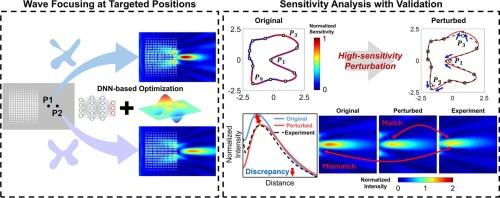基于dnn的梯度折射率声子晶体形状优化及其可调焦位和鲁棒能量收集的灵敏度分析
IF 7.9
2区 材料科学
Q1 MATERIALS SCIENCE, MULTIDISCIPLINARY
引用次数: 0
摘要
梯度指数(GRIN)声子晶体(pnc)通过将弹性波聚焦成电能来实现能量收集(EH)。高效的EH需要最大化聚焦波强度,通常通过调整GRIN pnc的单元形状来实现。然而,现有的设计往往在GRIN透镜边界附近表现出能量集中,并包含窄间隙和尖角,使它们容易受到制造误差的影响,限制了它们的实际适用性。了解由制造误差引起的潜在性能变化非常重要,因为几何变化会影响波聚焦性能。因此,本研究旨在优化单元胞形状,以在EH器件所需位置获得最大聚焦强度。为了评估可制造性,通过灵敏度分析评估了微小几何变化对焦点位置和聚焦强度的影响。使用深度神经网络(DNN)替代模型来预测焦点位置和聚焦强度,从而获得最佳形状。该模型加速了遗传算法的优化。与传统设计相比,我们优化的设计在目标焦点位置上的聚焦强度提高了1.5至2.0倍。因此,这些最佳形状及其灵敏度分析结果为定义制造公差和实现一致、高效的EH性能提供了实用指南。本文章由计算机程序翻译,如有差异,请以英文原文为准。

DNN-based shape optimization of gradient-index phononic crystals with sensitivity analysis for tunable focal position and robust energy harvesting
Gradient-index (GRIN) phononic crystals (PnCs) enable energy harvesting (EH) by focusing elastic waves into electrical energy. Efficient EH requires maximizing focused wave intensity, typically achieved by tuning the GRIN PnCs unit-cell shape. However, existing designs often exhibit energy concentration near the GRIN lens boundary and incorporate narrow gaps and sharp corners, making them susceptible to manufacturing errors and limiting their practical applicability. Understanding the potential performance changes caused by manufacturing errors is important because geometrical alterations can compromise wave-focusing performance. Therefore, this study aims to optimize the unit-cell shape toward maximum focused intensity at the desired locations for EH devices. To assess manufacturability, the effects of minor geometric variations on the focal position and focused intensity are evaluated via a sensitivity analysis. The optimal shape is derived using a deep neural network (DNN) surrogate model trained to predict focal position and focused intensity. This model accelerates a genetic algorithm (GA) used to perform the optimization. Our optimized designs exhibit 1.5 to 2.0 times higher focused intensity across the target focal positions compared with the conventional design. Thus, these optimal shapes, along with their sensitivity analysis results, provide practical guidelines for defining manufacturing tolerances and achieving consistent, efficient EH performance.
求助全文
通过发布文献求助,成功后即可免费获取论文全文。
去求助
来源期刊

Materials & Design
Engineering-Mechanical Engineering
CiteScore
14.30
自引率
7.10%
发文量
1028
审稿时长
85 days
期刊介绍:
Materials and Design is a multi-disciplinary journal that publishes original research reports, review articles, and express communications. The journal focuses on studying the structure and properties of inorganic and organic materials, advancements in synthesis, processing, characterization, and testing, the design of materials and engineering systems, and their applications in technology. It aims to bring together various aspects of materials science, engineering, physics, and chemistry.
The journal explores themes ranging from materials to design and aims to reveal the connections between natural and artificial materials, as well as experiment and modeling. Manuscripts submitted to Materials and Design should contain elements of discovery and surprise, as they often contribute new insights into the architecture and function of matter.
 求助内容:
求助内容: 应助结果提醒方式:
应助结果提醒方式:


